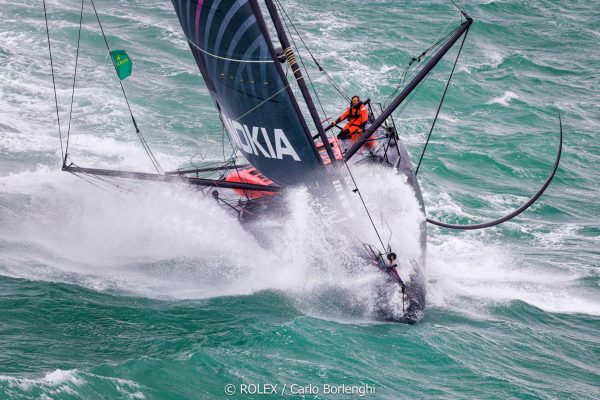The world's biggest offshore yacht race, the Rolex Fastnet Race, started today. Competitors can expect a tough first night after setting off from Cowes in demanding conditions which saw some big names forced out of the race early on.
White-capped waves, a building swell, and gusty breezes saw the world’s biggest offshore yacht race, the Rolex Fastnet Race, start this morning from Cowes, on the Isle of Wight, in demanding conditions.
Winds across the Solent were steady 25 knot south-westerlies, gusting into the mid 30s, as the 337-boat fleet started from the Royal Yacht Squadron line.
The large racing fleet and spectator flotilla churned up an already confused sea state off Cowes, and as the fleet powered west towards the tidal overfalls off Hurst Narrows that sea state only increased to 1m plus waves.
The tricky early stages saw a number of incidents, including collisions and retirements. Yannick Bestaven’s winning Vendée Globe IMOCA, Maitre Coq IV, had to retire very early following a collision with another vessel that caused damage to the IMOCA 60 bow.
The Maserati Multi 70 skippered by Giovanni Soldini was also forced to retire due to damage at around 1830 pm.
Soldini said: “We were sailing at 20-25 knots when the winch drum exploded. We had just replaced it, it was new, it probably had some structural damage.”

Giovanni Soldini’s Multi70 Maserati and Jason Carroll’s MOD 70 Argo exit the Solent after the Fastnet Race start © Carlo Borlenghi/Rolex
Other race favourites to get knocked out early in the race were two serious MOCRA contenders: Christian Guyader, the 2019 winner, on his highly fancied TS5 catamaran Guyader Mext, and Yann Marilley’s Outremer 5x Racing catamaran No Limit, racing with ocean sailing legend Loick Peyron, which had to retire after dismasting.
Given the boisterous forecast, the race officers had decided to reorder the classes for the Fastnet Race start, sending the two multihull divisions – MOCRA and Open, which includes the four giant Ultims – off first, followed by the IMOCA 60s and Class 40s together, then IRC Zero, IRC 1 and Figaro 2, then IRC 4, IRC 3 and IRC 2.
This was a reschedule from the previous plan of starting the IRC Zero fleet last, creating the famous Fastnet Race start spectacle of fleets mixing it up, amateurs and family crews racing alongside the largest, professional teams.
Organisers decided that with today’s conditions it was prudent to allow the less manoeuvrable maxi yachts, which includes the biggest yacht ever to compete in the Rolex Fastnet Race, the 140ft ClubSwan 125 Skorpios, through the Narrows first.

Tough Fastnet Race start
Almost all fleets initially started without incident. With tide taking the fleet down to the line, and a lumpen sea state, most fleets were conservative and started cleanly.
First to cross the line were Thomas Coville’s Sodebo and Charles Caudrelier’s Maxi Edmond de Rothschild, which both hit the line at pace and powered away. The dark blue Gitana branded Maxi Edmond de Rothschild took the early advantage, and was first out of the Solent to take the early race lead.

Dmitry Rybolovlev’s ClubSwan 125 Skorpios and George David’s Maxi Rambler 88 beating into the English Channel © Carlo Borlenghi/Rolex
However, with such challenging conditions and a crowded racing area off the start there were numerous incidents as the fleet tacked out to the western Solent, including collisions, torn sails, forestay failures and three dismastings in the very early stages.
By early evening Cowes Yacht Haven was dotted with boats flying Rolex race flags who had opted to return, and 39 boats and retired from racing.

Windy start to the 2021 Rolex Fastnet Race © Martin Allen/pwpictures.com
The forecast for the first 24 hours of this year’s Rolex Fastnet Race is going to continue to make for a tough first night for competitors.
For Sunday night competitors can expect strong winds of 23-28 knots in the English Channel, with acceleration zones around the headlands are likely to increase that to 30 knots. With wind against tide this evening, a short and steep sea state is expected around St Alban’s Ledge and Portland Race.
Winds are forecast to ease by Monday morning as competitors make miles to the west, but only expected to initially abate to 18-23 knots, dropping off further by Tuesday.

As competitors enter the Irish Sea, the wind is expected to back, then veer to the west around the Fastnet Rock. However, by Wednesday there will be a slow moving area of low pressure system west of Ireland, which is creating some uncertainty about where, and how quickly, the fronts will move and which portion of the fleet can anticipate southerly or westerly breezes after rounding the Rock.
The leaders heading to Cherbourg can expect light winds off Brittany, but by Thursday south-westerly winds are expected to blanket the race course, building into Friday.
So far, it is too early to call whether the 49th Rolex Fastnet Race will be a big boats’ race, or if the small boats will have a later advantage.
Find out how to follow for all the race updates and exclusive Yachting World content here




